Ciabatta Bread
This easy ciabatta bread recipe results in beautiful rustic loaves of classic Italian bread, with its perfectly chewy interior texture studded with those wonderfully large air bubbles. It’s practically begging to be dipped into your favorite soup or stew.

I have such a love affair with baking homemade bread; the smell of yeast and fresh, rising dough has such a calming effect.
It makes me want to curl up on a covered wrap-around porch and read during a rainstorm.
Why You’re Going to Love It
I've long loved ciabatta bread for its chewy exterior and soft crumb speckled with air holes. It's the perfect bread for dunking into soup, slicing horizontally and making a sandwich, converting to garlic bread, or for simply slathering with butter and eating until your heart's content.
This recipe is not complicated, although it does take a little bit of planning ahead. Actual hands-on time is less than an hour in total, and the dough is very forgiving. Let’s dive into the details of the recipe!
Ingredients Overview
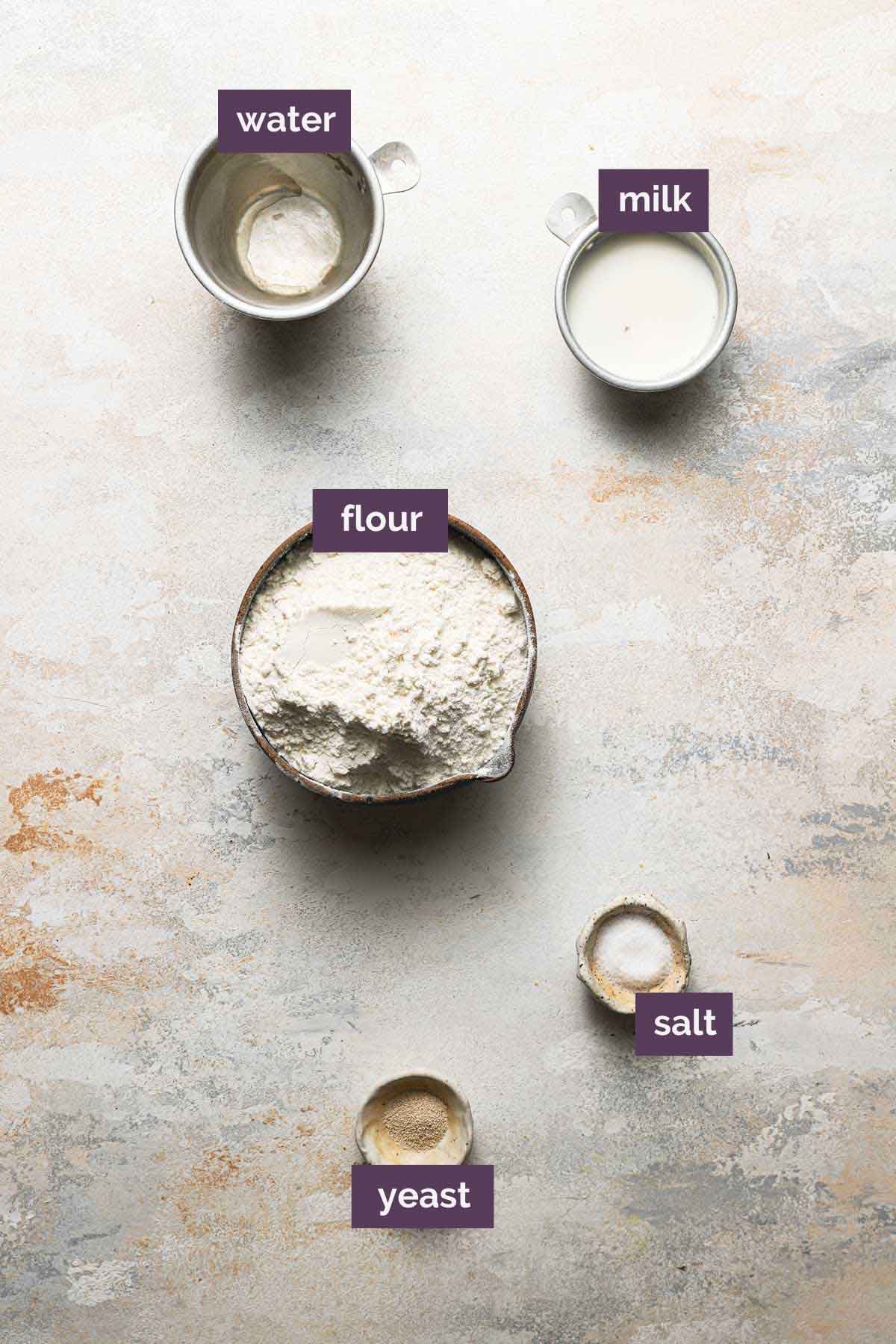
The beauty of this bread is its incredibly simplistic and rustic nature. Below is a quick overview of the ingredients we use with some notes on them and substitutions you may be wondering about:
- Flour – For this recipe, we use all-purpose flour. It has the perfect amount of protein to produce a ciabatta with a perfect rise and airy texture. Substituting bread flour will result in a denser, chewier, and less airy loaf of bread.
- Yeast – We use instant yeast, which is easily mixed into dry ingredients. If you need to substitute active dry yeast, be aware that you will need to activate it in both the sponge and the dough by first ensuring that the water is warm (100 to 110 degrees F), sprinkling the yeast over the water, giving it a quick stir, and then waiting 10 or 15 minutes, until it becomes foamy. At that point, proceed with the rest of the recipe.
- Water – A vital component! Ciabatta dough is considered a high-hydration dough because of the ratio of water to flour. For this reason, you will notice that it is rather sticky and a very wet dough. We’ll talk below about how best to handle the dough.
- Salt – Not only does this help to balance flavors in bread, but it also aids in coloring the crust, controlling the rise, and developing gluten. Don’t leave it out!
- Milk – A protein in milk helps to control the size of the air bubbles in the bread. Without it, the holes are larger, which doesn’t leave as much bread structure. The best milk is whole or 2%, but 1% can also be used in a pinch. You can also substitute 2 tablespoons of nonfat milk powder (increase the water in the dough step to 1 cup).
Ciabatta Dough: Two Parts
The dough for ciabatta bread is made in two stages:
- Sponge (or Biga) – This first mixture is prepared the day before you plan to bake the bread. It is comprised of just flour, yeast, and water. This fermented sponge is what gives the ciabatta its amazing, slightly tangy flavor.
- Dough – The next day, you will mix together the dough, which will include the sponge that has been sitting overnight.
How to Make the Dough
Let’s walk through how the dough comes together:
Step #1: Make the Sponge – You’ll mix together the flour, yeast, and water with a wooden spoon, cover the bowl with plastic wrap, and let sit overnight or for up to 24 hours.
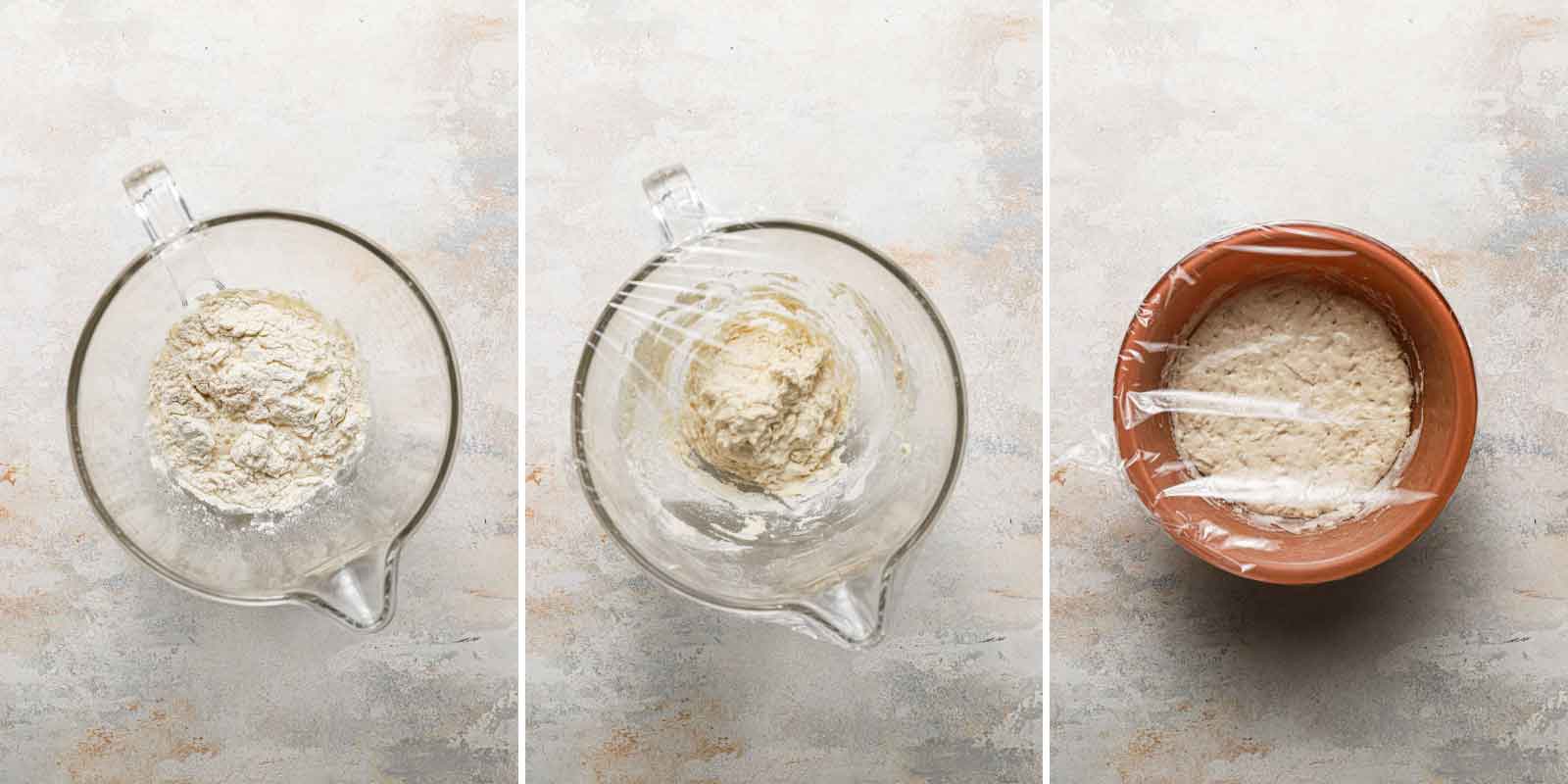
Step #2: Mix the Dough – Add the sponge and all of the dough ingredients to a stand mixer and mix with the paddle attachment until it becomes a uniform mass and pulls away from the sides of the bowl. Switch to the dough hook and knead until the dough is shiny and smooth (about 10 minutes).
Step #3: Rise – Transfer the dough to a bowl, cover with plastic wrap, and set at room temperature until doubled in size (about 1 hour).


Folding the Dough
This folding process may seem tedious, but it is an integral part of achieving those picture-perfect air bubbles! Here is how you do it:
Make sure your spatula or bowl scraper is sprayed with cooking spray (or rub it with olive oil).
Then lift the end of the dough over itself toward the middle, rotate the bowl 90 degrees, repeat, and then six more times, for a total of 8 times.
Save This Recipe
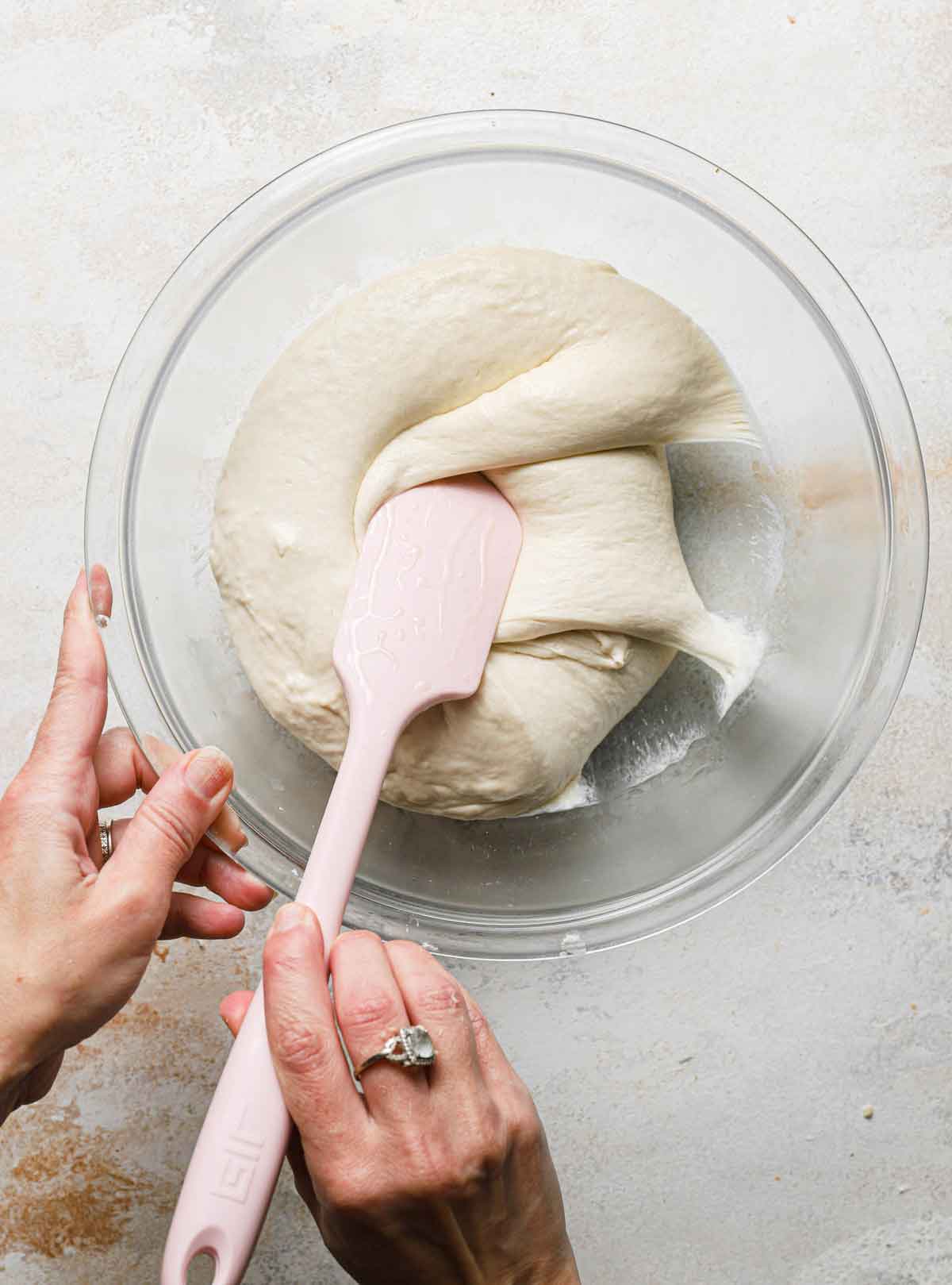
Cover the bowl with plastic wrap, let rest/rise for 30 minutes, then repeat the exact same folding process again.
Once done, cover the dough once more and allow to double in size before proceeding with shaping.
Shaping the Ciabatta
The final shaping of the ciabatta before baking is what gives the bread its characteristic “slipper” shape, from which its name originates (“ciabatta” means slipper in Italian; the bread was given this name because its shape resembles a well-worn slipper).
Shaping Step #1: Turn the dough out onto a floured surface gently (so it does not completely deflate), dust it with flour, and divide in half with a bench scraper.
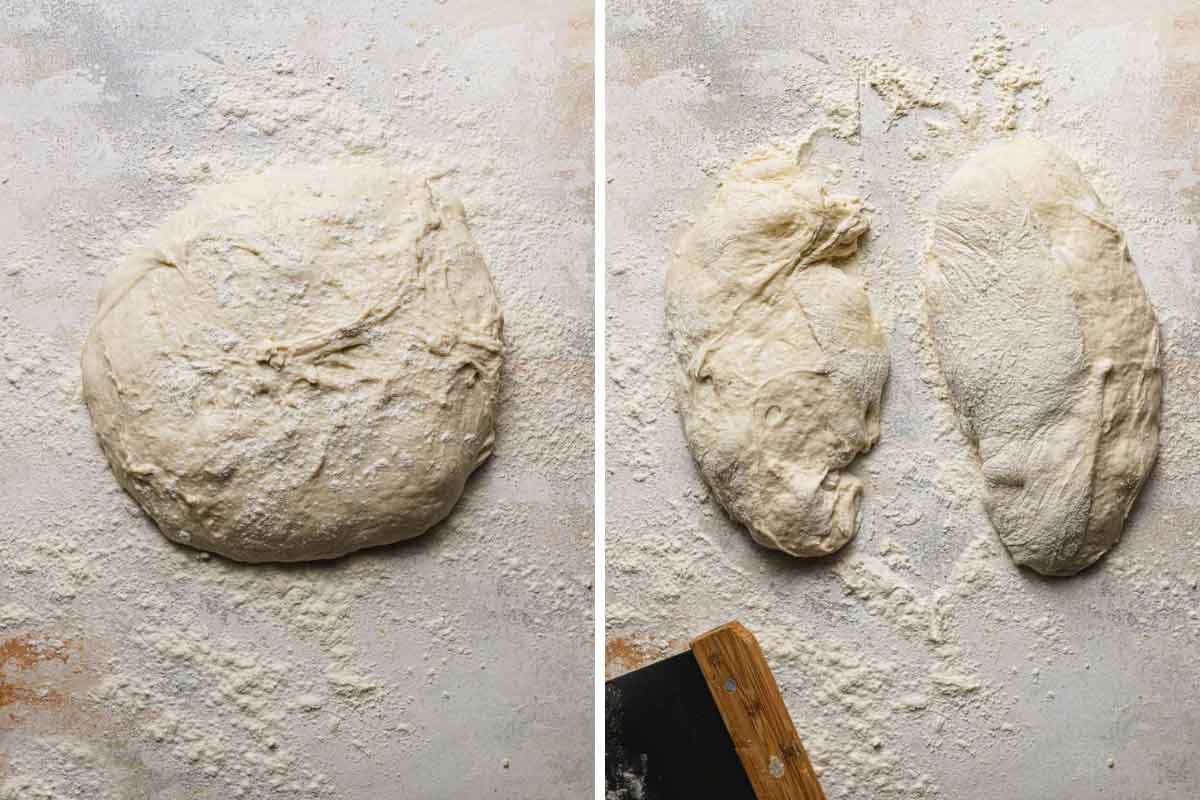
Shaping Step #2: Place one piece of dough cut-side-up and dust with flour, then using fingertips, gently press the dough into a 12×6-inch rectangle. Fold one end of the dough towards the middle, and fold the other end over the top of the first fold (as you would fold a letter in thirds). Repeat with the second loaf of dough.
Shaping Step #3: Transfer each loaf to a rectangular piece of parchment that has been dusted with flour. Dust the tops of the loaves with flour, cover with plastic wrap, and allow to sit for 30 minutes.
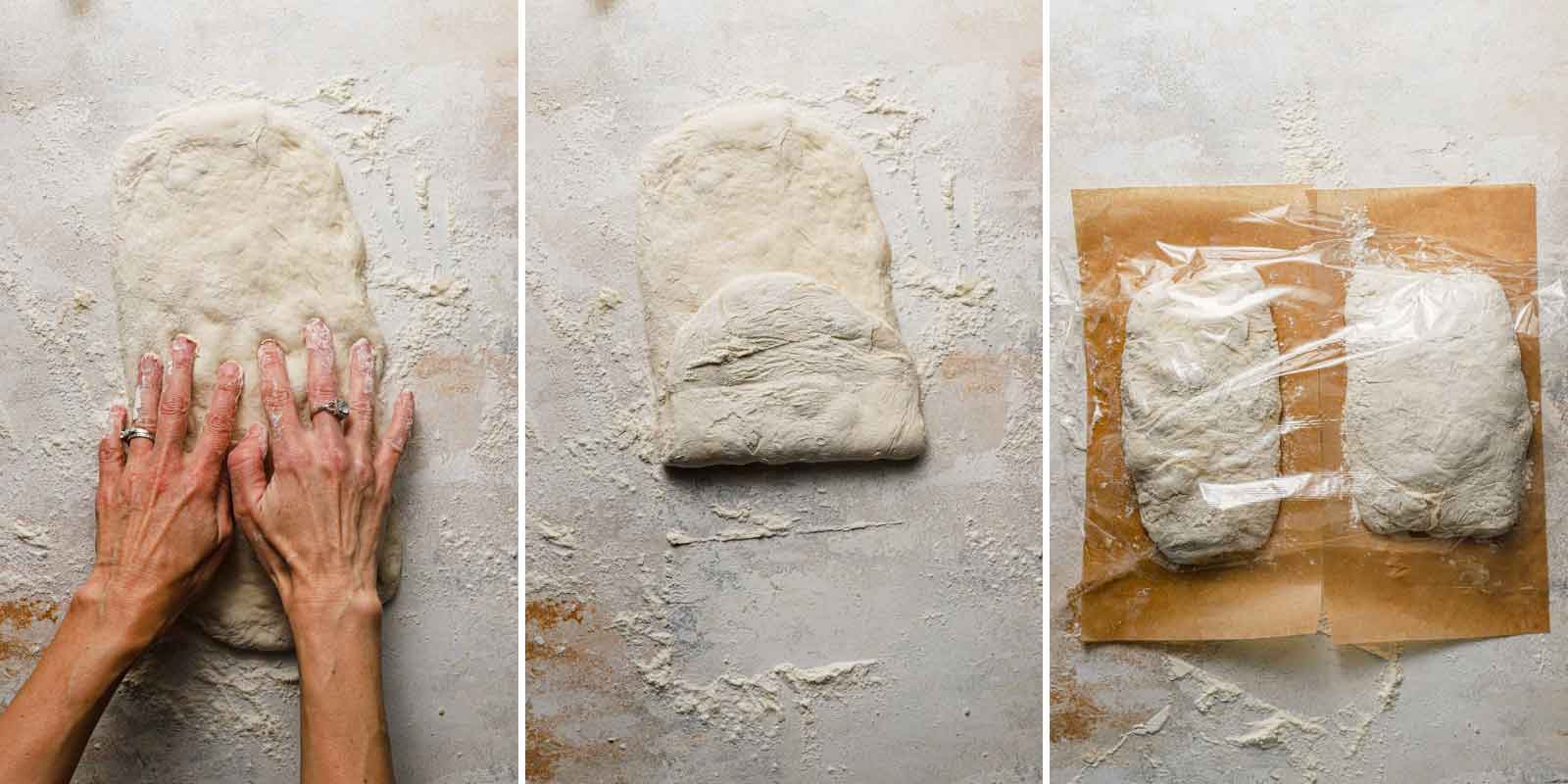
Baking the Bread
When the 30 minutes is up, you will slide the parchment pieces with the loaves onto a pizza peel. Use floured fingertips to poke the surface all over to create a 10×6-inch rectangle. Lightly spritz the loaves with water and slide the loaves onto a preheated pizza stone in the oven (you can also use an inverted baking pan, see notes below).
Spray with water twice more during the first 5 minutes of baking, then continue baking until the internal temperature registers 210 degrees F.
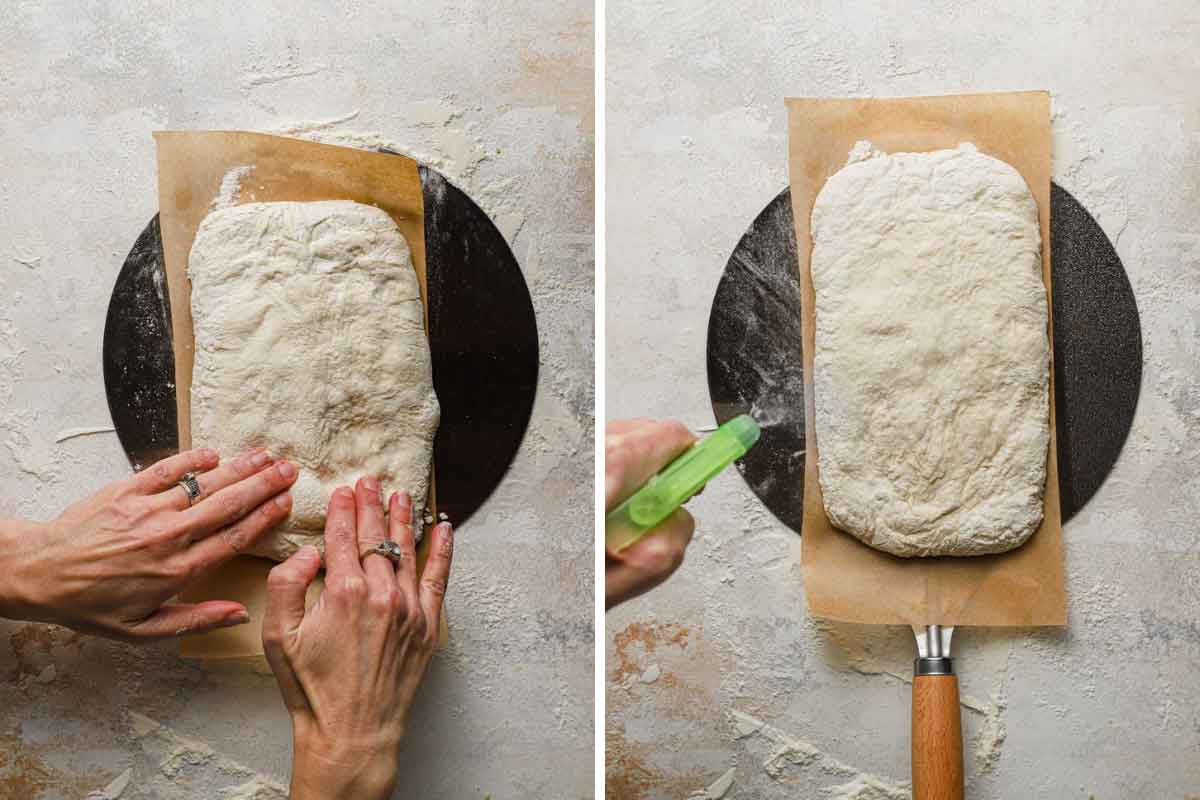
Recipe Notes and FAQ
A few notes and the answers the some commonly asked questions:
- Equipment – To make the most of this recipe, I recommend using the following pieces of equipment: stand mixer / bowl scraper / bench scraper / baking stone / parchment paper / pizza peel / spray bottle / digital instant-read thermometer / wire cooling rack
- Yeast – If you substitute active yeast instead of instant yeast, you will need to be sure to activate it in warm water first, instead of simply mixing it with the flour and room temperature water.
- Milk – Whole milk is preferred, but 2% or 1% can also be used. You can also substitute 2 tablespoons of nonfat milk powder (increase water in dough to 1 cup).
- Stand Mixer – Due to the high hydration of this dough and how sticky it is, a stand mixer is important for being able to manage the dough properly.
- Handling the Dough – Keep in mind that this dough is very wet and sticky; the key to working it well is to do so quickly and gently. Too much heavy-handling of the dough will result in flat, tough loaves. Use a bowl scraper when possible and if you need to use your hands, make sure they are well-floured.
- Baking Stone – If you do not have a baking stone, you can use a baking sheet that is turned upside on the lowest oven rack and preheated as directed.
- Making Ciabatta Rolls – To make rolls, use a bench scrape to divide each loaf into 6 or 8 even-sized portions. Separate them a bit on the parchment sheet so they aren’t touching.
- Storage – The bread can be kept at room temperature, wrapped in foil, for up to 2 days.
- To Reheat the Bread – Keep it wrapped in foil and place in a 450-degree oven for 6 to 8 minutes.
- Freezing the Bread – Wrap tightly in foil, then place in a ziploc freezer bag and freeze for up to 3 months. Thaw at room temperature, then warm and re-crisp the crust using the reheating method above.

More Popular Homemade Bread Recipes
- The Best White Bread Recipe
- Grandma’s Banana Nut Bread
- Copycat Pizza Hut Breadsticks
- Classic Italian Bread Recipe
- Spicy Cheese Bread
Watch How to Make Homemade Ciabatta Bread:
If you make this ciabatta bread recipe and love it, remember to stop back and give it a 5-star rating - it helps others find the recipe! ❤️️

Ciabatta Bread
Ingredients
For the Sponge:
- 1 cup (130 g) all-purpose flour
- ⅛ teaspoon instant yeast
- ½ cup (120 ml) water, at room temperature
For the Dough:
- 2 cups (260 g) all-purpose flour
- 1½ teaspoons salt
- ½ teaspoon instant yeast
- ¾ cup (180 ml) water, at room temperature
- ¼ cup (60 ml) whole or 2% milk, at room temperature
Instructions
- Make the Sponge: Combine the 1 cup flour, ⅛ teaspoon yeast, and ½ cup water in a medium bowl and stir with a wooden spoon until a uniform mass forms. Cover the bowl tightly with plastic wrap and let stand at room temperature for at least 8 hours or up to 24 hours.
- Make the Dough: Place the sponge and the dough ingredients (flour, salt, yeast, water and milk) in the bowl of a stand mixer fitted with the paddle attachment. Mix on low speed until combined and a shaggy dough forms, about 1 minute, scraping down the bowl and paddle as needed. Increase the speed to medium-low and continue mixing until the dough becomes a uniform mass that collects on the paddle and pulls away from the sides of the bowl, 4 to 6 minutes.
- Change to the dough hook and knead the bread on medium speed until smooth and shiny (the dough will be very sticky), about 10 minutes.
- Transfer the dough to a large bowl, cover tightly with plastic wrap, and let rise at room temperature until doubled in size, about 1 hour.
- Spray a rubber spatula or bowl scraper with non-stick cooking spray. Fold the dough over itself by gently lifting and folding the edge of the dough toward the middle. Turn the bowl 90 degrees, and fold again. Turn the bowl and fold the dough 6 more times (for a total of 8 times).
- Cover with plastic wrap and let rise for 30 minutes.
- Repeat the folding as in step #7, replace the plastic wrap, and let rise until doubled in size, about 30 minutes.
- One hour before baking, adjust an oven rack to the lower-middle position, place a baking stone on the rack and preheat the oven to 450 degrees F.
- Cut two 12×6-inch pieces of parchment paper and dust liberally with flour. Transfer the dough to a floured work surface, being careful not to deflate it completely. Liberally flour the top of the dough and divide it in half with a bench scraper. Turn 1 piece of dough cut-side-up and dust with flour. With well-floured hands, press the dough into a rough 12×6-inch rectangle. Fold the shorter sides of the dough toward center, overlapping them like you would fold a letter in thirds, to form a 7×4-inch rectangle. Repeat with the second piece of dough.
- Gently transfer each loaf, seam-side-down, to the parchment sheets, dust with flour, and cover with plastic wrap. Let the loaves sit at room temperature for 30 minutes (the surface of the loaves will develop small bubbles).
- Slide the parchment pieces with the loaves onto a pizza peel. Using floured fingertips, evenly poke the entire surface of each loaf to form a 10×6-inch rectangle; spray the loaves lightly with water. Slides the loaves and parchment onto the baking stone. Bake, spraying the loaves with water twice more during the first 5 minutes of baking time, until the crust is deep golden brown and the loaves register 210 degrees F, 22 to 27 minutes.
- Transfer the loaves to a wire rack, discard the parchment, and let cool to room temperature for at least 1 hour before slicing and serving. The bread can be wrapped in a double layer of plastic wrap and stored at room temperature for up to 3 days. Wrapped with an additional layer of foil, the bread can be frozen for up to 1 month. To recrisp the crust, thaw the bread at room temperature (if frozen), and place unwrapped bread in 450-degree oven for 6 to 8 minutes.
Notes
- Equipment - To make the most of this recipe, I recommend using the following pieces of equipment: stand mixer / bowl scraper / bench scraper / baking stone / parchment paper / pizza peel / spray bottle / digital instant-read thermometer / wire cooling rack
- Yeast - If you substitute active yeast instead of instant yeast, you will need to be sure to activate it in warm water first, instead of simply mixing it with the flour and room temperature water.
- Milk - Whole milk is preferred, but 2% or 1% can also be used. You can also substitute 2 tablespoons of nonfat milk powder (increase water in dough to 1 cup).
- Stand Mixer - Due to the high hydration of this dough and how sticky it is, a stand mixer is important for being able to manage the dough properly.
- Handling the Dough - Keep in mind that this dough is very wet and sticky; the key to working it well is to do so quickly and gently. Too much heavy-handling of the dough will result in flat, tough loaves. Use a bowl scraper when possible and if you need to use your hands, make sure they are well-floured.
- Baking Stone - If you do not have a baking stone, you can use a baking sheet that is turned upside on the lowest oven rack and preheated as directed.
- Making Ciabatta Rolls - To make rolls, use a bench scrape to divide each loaf into 6 or 8 even-sized portions. Separate them a bit on the parchment sheet so they aren't touching.
- Storage - The bread can be kept at room temperature, wrapped in foil, for up to 2 days.
- To Reheat the Bread - Keep it wrapped in foil and place in a 450-degree oven for 6 to 8 minutes.
- Freezing the Bread - Wrap tightly in foil, then place in a ziploc freezer bag and freeze for up to 3 months. Thaw at room temperature, then warm and re-crisp the crust using the reheating method above.
- Recipe from Baking Illustrated
Did you make this recipe?
Leave a review below, then snap a picture and tag @thebrowneyedbaker on Instagram so I can see it!
This recipe was originally published in March 2014.
Photography by Dee Frances.


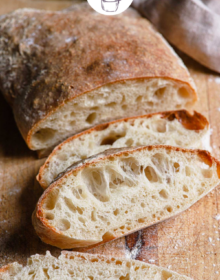



Today I made this bread for the first time according to your recipe. The result was wonderful .I took a picture of it .I am sure I will try more recipes from you . Considering that we don’t have good flour in Iran, but your recipe was perfect for me. You gave me a lot of excitement to bake bread
Today I made this bread for the first time according to your recipe. The result was wonderful . I took a picture of it . I am sure I will try more recipes from you . Considering that we don’t have good flour in Iran, but your recipe was perfect for me..You gave me a lot of excitement to bake bread.
Good luck
I love this bread, so easy to make,
Lovely baker! Loving it!
One question, the baking temperature is 450 degrees F or 210 degrees F?
Preheating oven is at 450 and baking is at 210 degrees F for 22 to 27 min?
Thank you for a wonderful recipe.
Ooo I do love this ciabatta recipe! Made it 5 times now and it’s always a winner. Excellent clear instructions and a beautiful result. No need to ever buy ciabatta again ❤️
i don’t have a baking stone. Can i use a cookie sheet instead of baking stone?
Ciabatta Bread recipe is the best. First try at ciabatta and it was delicious. Dough was so silky & smooth after kneading. My go to recipe from now on. Thank You for tasty Ciabatta bread.
THE BEST Ciabatta Bread I’ve tried. I doubled the recipe and hoped for the best and got it! I reduced the salt to half. I didn’t have whole milk so I used 1/8 cup 5% cream and 1/8 cup 1 % milk. Soft inside, lots of sponges and crusty on the outside. Rose beautifully. Amazing! Thank you!!!
My first time making a bread that wasn’t garlic knots and it turned out AMAZING, this will definitely be a forever recipe of mine. Made it about two weeks ago now I’m doubling it so I can give a loaf to a friend. I wish I could upload a picture!
This was an excellent recipe! I can’t post a picture either. I used to have a request to post a picture but now it doesn’t ask. Odd….
interested in breads
Do you have any move bread recipies other than ciabatta
/
Curious if you made this with olives. A restaurant nearby has olive ciabatta and I would love to make this at home. Any suggestions for when to add olives?
Just so you know I’m not that other Robert ^*
I made this recipe into six buns instead of two loaves. Amazing, I still can’t believe I made them myself. Thanks so much for the recipe!
This is the fourth time I’ve made this recipe. I love it. So easy and good. Hasn’t failed me yet.
Do you have to add the milk and if so I was wondering what is the purpose of adding milk? Thanks
Hi Sandra, Yes, milk adds moisture and fat. Enjoy the bread!
Can the recipe be doubled? I’m working on my first batch-still in the mixing stage- but if it turns out I want to make more so I have enough for chicken BLTs for 14 people or so, so I’m gonna need lots!
Hi Karen, Yes you can double it!
Seemed like a lot of work but I eventually baked a loaf and it turned out great, in fact better than some of the shop bought ciabattas I’ve had. I did cheat though as I used a bread maker to make the dough.
I don’t have a spray bottle.
What can I use ?
Hi Vickie, You can place a shallow metal pan on the bottom rack and pour water into it when you put the bread in the oven – it will create steam and mimic the spray effect. Enjoy!
I feel like I always come back to your recipe, it’s been years! One question? Can I store the second loaf to back the next day? Store in the fridge or leave out? Have you ever attempted this?
Hi Octavia, I haven’t tried that. I might move the dough to the fridge after the first rise if you’re looking to shave some time.
How does the yeast activate if the water is at room temperature?
Hi Jan, Instant yeast is used in this recipe, which does not require activation with warm water.
Hi, Jan. I used regular yeast in this recipe and altered it slightly:
I followed this recipe except I got all the liquids (water and milk) to 110 degrees Fahrenheit, let the starter rise for the full 24 hours and added 30 minutes to each rising step. Came out great!
Oops, I meant to say I added 30 minutes to the first rise the next day when I added the starter to the 2 cups of flour and new yeast.
This is the best ciabatta I’ve made so far. And I’ve been experimenting a lot since I got a stand mixer. Everything was perfect, except the crust didn’t stay crisp. After cooling, it got more rubbery. I sprayed it 3 times as directed. I need to figure out how to crusty it up a bit.
Will try this Ciabatta recipe. Your recipes have been just right so far. And so many of them I make regularly now. I really should post some photos. Haven’t made this yet but everything seems right so I will try tomorrow.
This is by far the best bread recipe I have ever made. Yes, it was a little difficult at first, but once you get the hang of it is very simple and extremely tasty. Today. I made ciabatta rolls and they turned out wonderful. Thank you so much.
Holy smokes this is good bread! I’ve made a lot of bread but had never made ciabatta before. I had a pot of beef stew cooking and was looking for a good bread to go with it. I saw the recipe pop up on Facebook recently and decided to give it a try. The directions were easy to follow, and I was very pleased with the results. It was only by great restraint that we didn’t eat both loaves.
Can this be made in a bread machine?
Hi Sara, I haven’t tried it, as I don’t have a bread machine, but if you do, please let me know how it turns out!
Holy smokes, I made ciabatta! Thank you so much for this recipe. Easy to follow and the video really helped. This bread is absolutely amazing. It lasted about 10 minutes.
I’ve read through many of the comments and no one mentioned that you have somehow double numbered the steps. The number 3 step referred to in a later step is has a 5 in front, then if you look closer, then there’s a 3. Confusing!
I love your recipes and have never seen this before. I look forward to trying this soon!
Not sure what happened, the bread came out tasting ok but no big holes as in real ciabatta bread, I’m so disappointed! What could have happened? I followed directions except used active dried yeast and not instant. Could that have made the difference?
Hi Linda, The yeast substitution definitely could have been the culprit; since the recipe calls for instant yeast, we don’t need to activate it with warm water, instead it is mixed into the dry ingredients and we use room temperature water. In addition, instant yeast gets by with shorter rise times, so it’s likely your active dry yeast may not have had enough time to develop and that airy, holey look.
What is the role of milk in this recipe and can non-dairy be substituted? Does milk help with gluten development from something in the dairy milk or is it mainly for adding fat and liquid?